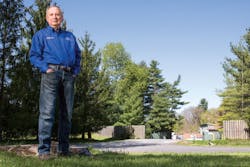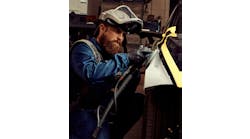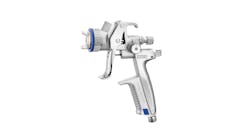There was a moment when Chuck Scilipote saw it all sink in.
He strolled the shop floor at his Reisterstown, Md., repair facility, Auto Collision Specialists, glad-handing, touring and teaching the 60 or so members of the Mercedes-Benz Club of America at his business that Sunday for an open house.
He showed them the equipment—his Celette bench, the specialty jigs and fixtures, the rivet gun, the welders, everything that goes into fixing their modern, sophisticated, aluminum-intensive vehicles.
Standing in front of a welding display his staff created—which demonstrated each of the five types of welds required on Mercedes vehicles—Scilipote saw the light bulb go on for one of his customers.
“He spent his whole career in an airplane factory,” Scilipote explains. “This guy knew about aluminum; he knew about the riveting process, the welding, all of it. And it was just like, ‘Wow, these cars are built a lot like airplanes.’ And, you know, he’s right.
“Aluminum is a whole different animal. I’m not saying it’s harder, but it’s more sophisticated, time-consuming (to repair)—it’s just different.”
And according to some, it’s on the verge of changing the collision repair industry.
Dean Fisher, vice president of operations for CARSTAR, said 30–40 percent of new vehicles will require an aluminum repair process in the next several years. The 2015 Ford F-150 has taken advanced materials from the novelty, specialty and exotic segment to Main Street America.
And it’s only the beginning of the automaker transition to advanced materials. Carbon fiber could be next; BMW already has its carbon fiber–bodied i3, and a study from Lux Research stated that use of carbon fiber reinforced plastics will be mainstream by 2025. In April, Ford Motor Co. announced that it is working to develop cost-effective methods for the mass production of carbon fiber in vehicles.
But actions speak louder than words, and large industry players are quickly adjusting. Fisher helped launch and design CARSTAR’s aluminum certification protocol last year, and he says the company expects to have 70–80 of its 250 or so U.S. locations aluminum-ready in the coming two years; of the company’s roughly 400 facilities in North America, nearly half are working toward achieving aluminum qualifications.
“The vehicles this year, there’s a lot of aluminum frame and ancillary aspects that require the aluminum [repair] process,” Fisher says. “This stuff has been here for a while, but unless you were a BMW or Jaguar Land Rover shop or along those lines, you weren’t paying attention.
“Well, now it’s time to pay attention.”
Let it sink in, Scilipote says. A new era of collision repair is starting, and shops need to understand the ins and outs of advanced materials to be equipped, educated and competitive for the future.
Taking A Look Back—and Two Steps Forward
So, how new is advanced materials use in vehicles? The first car featuring aluminum body elements debuted at the Berlin International Motor Show … in 1899.
“This isn’t a new concept,” says Shawn Collins, senior technical service engineer for 3M. Aluminum has always been an option—until recently, a very expensive and impractical option, Collins says.
From the time of that 19th century aluminum vehicle in Germany until the early 1990s, few advances in aluminum-body design were made. The auto industry gradually worked aluminum into powertrains and engine design, but the first true commercially available aluminum-bodied vehicle came in 1994, the Audi A8.
Because of the expense, it remained a luxury vehicle concept for years. But the CAFE standards for fuel economy and technological advances in aluminum manufacturing caused mainstream automakers to rethink aluminum use in recent years. Aluminum components started creeping into vehicles—hoods, liftgates, etc. Then came the Ford announcement in 2012 that it would begin manufacturing an aluminum-bodied F-150 for 2015.
Now, aluminum use is gaining steam, Collins says. GM and Chrysler have aluminum-bodied vehicles planned, and Toyota announced last September that its Camry will have aluminum components by 2018.
“One of the big differences,” he says, “is that if it’s just components, it’s more of a replacement issue, with things like hoods or liftgates. When it becomes a structural component of the vehicle, everything changes for shops.”
Collins is part of 3M’s alternative body materials team, which researches exotic structures and how they would work in vehicle design and repair. They created the company’s standard operating procedures for working on aluminum, and they’re currently looking into carbon fiber, as well as various high-strength steels.
The future of carbon fiber is still somewhat of a mystery, Collins says. There are a number of luxury brands like Aston Martin and BMW who’ve used it, but there are many variations of the material and no standard form has been established in the industry.
Still, he says not to sleep on it.
“Think of how aluminum changed: All it took was Ford taking it to a mainstream vehicle, and it exploded,” he says. “The same thing could happen with carbon fiber if, say, Toyota made a Camry with all body panels in carbon fiber. And this could happen. If it’s a mainstream vehicle, you’ll see the same reaction.
“Between the two (aluminum and carbon fiber), the [collision repair] industry would all of a sudden need to take two huge steps forward.”
Get Onboard
Scilipote has seen aluminum in his shop since he opened it as a one-man operation in 1980. The shop started specializing in Mercedes repair roughly four years after that, and joined the Mercedes-Benz Certified Collision Program in 2003. Auto Collision Specialists was one of the first shops in the Northeast to join the automaker’s then-brand-new aluminum structural certification program in 2013.
His shop is a pristine example of the modern, properly trained and equipped independent repair facility. But set a few hundred yards off the road in a suburban neighborhood, Auto Collision Specialists, with its wood-sided main building and understated signage, more closely resembles the houses next door.
His $2.8 million-a-year family business (his wife does the books, and his three sons all play critical roles in day-to-day operations) is very much a part of the community.
And this is where Scilipote’s open house comes in. He wants to blend the perception of a local body shop with the reality of the job complexity his team handles on a daily basis.
In order to maintain his shop’s Mercedes-certified status, he has to send his lead tech (his middle son) to quarterly welding certification courses in Texas. His entire staff has had to go through Mercedes-specific training. They’ve invested in the latest, top-of-the-line equipment, and he and his staff are capable of performing any job that comes their way.
That’s what he tried to get across through his presentations at the open house: Working on advanced materials—and aluminum in particular—isn’t just for the big boys; it’s about a dedicated team that’s focused on precision, quality and pushing the business forward.
“I know a lot of shops look at it on paper and say that it’s just not worth it,” Scilipote says. “One day, it’ll get to a point where you can’t do business without it, and they’ll be left behind.”
Scilipote admits he had a great head start, as he was 100 percent equipped already in 2013, simply from past experience on Mercedes vehicles. Still, he says, other shops can make incremental investments to get up-to-date, as well.
Collins says it’s a necessity. He remembers the days when shops dismissed unibody work as a fad they’d never have to deal with.
“I think that’s a fair comparison to where we’re headed with [advanced materials],” he says. “It’s not going anywhere. … If the information that we have is true and all these platforms will be aluminum, I think it’s imperative for shops to invest—or they’ll get left behind.”
Repairability, Profitability and the Future for Shops
Scilipote believes his shop’s expertise in advanced materials allows it to remain competitive in an industry slowly moving to a big-box model.
Still, Collins believes, as many do, that the sophistication of modern repair procedures and the overall expense of equipment, training and certifications favor multiple-shop operations (MSOs).
Fisher doesn’t disagree. The cost of the average repair facility (based on numbers for the CARSTAR shops he oversees) to jump into an aluminum certification program ranges from $150,000–$200,000. To become aluminum “recognized” for programs such as Ford’s, the cost is a little more forgiving, but still tops $50,000.
CARSTAR, Fisher says, is analyzing its individual markets and looking to balance the number of total shops against the number of aluminum-capable shops to load level the work.
“If you have a market with, say, 20 shops, maybe we need between five and eight that are aluminum equipped,” he explains.
And Collins says that appears to be the approach most of the largest MSOs are taking. It lowers their cost of entry, and allows them to still handle all work that comes through their doors. It allows for a quicker return on the investment for the company overall and for the individual shops.
Shop owners like Scilipote simply don’t have that luxury. He needs to make his own investments, gain his own work, and deliver his own return.
The repairability of the material, he says, isn’t the biggest concern. There are nuances to it, and a learning curve. He says it “isn’t harder, but it’s very, very different” to work on. Once you get through the training, work on a few vehicles, he says, you get the hang of it.
Of course, there’s the issue of getting paid properly. Scilipote does not operate on any direct repair programs; he says it’s too difficult to maintain Mercedes-level work. He does have two separate labor rates: one for standard repair work ($46) and one for aluminum work ($86). The key to proper reimbursement, he says, is properly written labor estimates and detailed repair reports.
Fisher says CARSTAR’s insurance relations team has worked closely with carriers to develop an understanding on the “complexity of the work.”
“That complexity requires more time of study and planning,” Fisher says. “You might not be touching the vehicle, but for a vehicle there could be an hour or an hour-and-a-half that you’re still working on it. No one recognizes that right now. That’s labor time.”
The solution is education. Again, that’s where the open house comes in for Scilipote, and that’s why his shop’s website has regular blog posts about advanced materials. His shop’s social media is flooded with aluminum information, as well.
Shops need to set a standard for reimbursement today, he says, so that when the materials become even more prevalent, they are able to do profitable work.
“It’s just about finding that moment where [the industry] as a whole has that light bulb go on,” he says. “This is the way it’s heading, it’s the future. You have to be on board, or you’ll sink.”
Certified vs. Recognized
Shawn Collins, senior technical engineer for 3M and a member of the company’s alternative materials team, says that it is a matter of time before aluminum becomes commonplace in all shops. However, the cost of entry to work on it is steep.
Current certification programs require heavy investments in specific sets of tools and pieces of equipment. Shops with multiple certifications may need a separate rivet gun for each automaker, for example, Collins says.
Ford’s program to ready shops for the 2015 aluminum-bodied F-150 pickup differs, though. Run through Assured Performance Network, it “recognizes” properly equipped, tooled, trained and staffed facilities that are able to make repairs on the new vehicle.
The largest difference between the programs, says Dean Fisher, vice president of operations for CARSTAR, is that the recognition program allows “segmented repairs,” meaning aluminum work can be curtained off from the rest of the shop in an otherwise traditional bay. In certification programs, shops need a clearly defined and separate clean room.
Fisher says the two different approaches to aluminum readiness—certification and recognition—may butt heads in the future.
“If aluminum does become a go-to material for the majority of automakers,” he says, “there will need to be more standardization across the industry, and not so specified to one make.
“You look at Ford, and they have Main Street vehicles, and they worked on a Main Street repair protocol for them. You have to commend them for that.”
The CARSTAR Aluminum Program
In mid-2014, CARSTAR announced that it would become the first of the country’s largest MSO networks to have its own aluminum-readiness program.
Dean Fisher, vice president of operations for CARSTAR, helped create the program. He says it follows as the final steps of the company’s overall training program for facilities, the Edge Performance Platform.
The first steps include operational improvements and team training in areas such as lean manufacturing; fast-tracked, express work; and company culture.
When shops have completed those other phases, they work on aluminum readiness. CARSTAR then works with the shops on analyzing the aluminum programs—e.g., specific manufacturer certification or Ford’s recognition program—that best meets the shop’s individual needs. Then, they consult the shop owners through the process.





